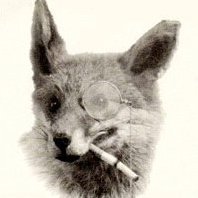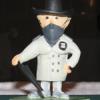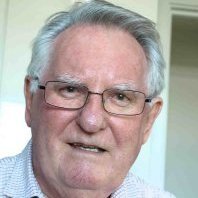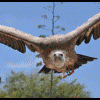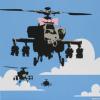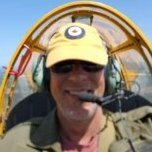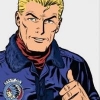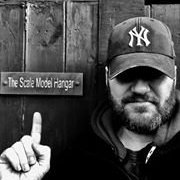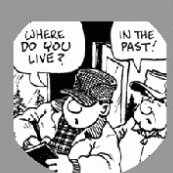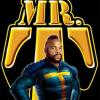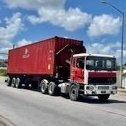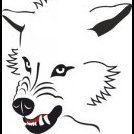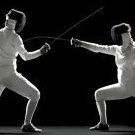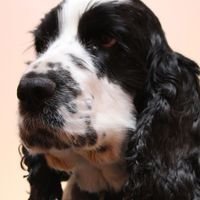Leaderboard
Popular Content
Showing content with the highest reputation on 24/10/17 in all areas
-
Like the Stranraer, I started this one early this year. The kit / aircraft always attracted me since it came out in the 70s but I never picked one up until a bargain offer .. 25 bucks from memory...I couldnt refuse came up at an Expo swap and sell last year. One of the reasons I didnt get one before was that it was a one operator machine.. Japan (though India is getting a few soon) and I just didn't fancy doing one of them. I thought I might try a civil WIFFer but thought that a bit silly and shelved the problem till later, then when in the UK last year the refugee avalanche into Europe with all the associated boat sinkings and drownings were raging headlines, with vision of search aircraft and rescues. Hmmm I thought, here was a job for a capable amphibian! So this Wiffer was born... It took me ages, I spent hours tooling around trying to come up with a believable / appropriate colour scheme and came up with this..I like it. The pics are not great, I will do better after make a stand to pose the model in a flight mode.20 points
-
Hello All After 11 months, I have completed the conversion of the Monogram B-36 to the YB-60 Jet engined prototype. It has been a long slog, with the USAF SIG's anniversary show at Telford as the must do by date. The easiest part of the conversion was the fuselage with small changes on the nose and tail being required. The wings and tail empennage not so simple. I think I used 5 or 6 tubes of Milliput for that. The engines were donated by an old B-52 kit. The engine pylons were adapted B-52 pylons as well. The wings were kit wings modified by removing the original engines and a lot of filling. Undercarriage is the SAC metal legs for added strength (it is kind of heavy). A new leg at the rear was fashioned from brass tube. Without that it would be a tail sitter, so thank you Convair for adding that. Paint is Halfords Aluminium, with various other paints for contrast. The markings are hand painted with decals for national markings. I hope you like it. Ted19 points
-
Good evening one and all. Adding to my little collection of Prototypes, experimental and research aircraft is this my latest model, YF4K Prototype at the time of its' first flight 27th June 1966 and flown by Joe Debronski. The base kit is the Fujimi F4K kit of which much has been written and with good reason, it is a superb kit considering it's age and went together with no real issues. During the build I moved the 2 lower auxiliary doors further forward as per UK Spey Phantoms, adding some detail to the u/c bays and airbrake wells and scratchbuilding new seats, although, I have to admit these may be wrong due to the fact I could find no decent pics of the MB Mk 5 with the sugar scoop head area. No photo etch was used so no mirrors adorn the canopy's. All the tubes were removed and replaced with Albion Alloys tubing. On the paint side of things Mr Colour White for the underside, Humbrol Dark Sea Grey for the top surfaces and Alclad for the metal areas around the exhaust. Everything was sealed with Alclad Gloss Coat The markings were from RAM models sheet of early British Phantoms and were very delicate to say the least, even in water extreme care was needed and using X20A to settle them was a no no, I tried on a never to be used decal and it just disintegrated. Anyway they did settle with the use of Mr Setter and Softer but there is some silvering. Thanks to those whom answered some of my questions regarding this build and helping me finish it. Hope you like her and thanks for looking. Disclaimer; All the usual cock-ups and mistakes apply!16 points
-
Hello, This T-33 is the reproduction of the jet flown by Tanguy & Laverdure. Heroes French comic strip. For the metal I used the Rub'N Buff Best Regards, Michel16 points
-
This is my Airfix 1/48th scale finished in Irish Air Corps markings. I found the kit to be very well engineered and particularly strong when assembled. The plastic is somewhat soft and tolerances are quite tight so a bit of fettling of the mating surfaces was required. I used the Eduard interior set, some of the exterior set too, particularly the engine parts, tie down eyes and the control surface linkages and the Brassin wheels set. Although I believe guns were never carried by IAC Walrus's I added them anyway using artistic licence. Rigging is a mixture of EZ line, Wingnuts rigging elastic, USCHI and rolled wire. Decals are of course from Max. Thanks for looking. IMG_2776 by Keith Sherwood, on Flickr IMG_2778 by Keith Sherwood, on Flickr IMG_2784 by Keith Sherwood, on Flickr IMG_2779 by Keith Sherwood, on Flickr IMG_2782 by Keith Sherwood, on Flickr15 points
-
11 points
-
Dear fellow Britmodellers, this is Airfix new 1/72 Messerschmitt Me-262 A1a built with the addition of Eduard photo etch & Master pitot tube. Painted with Gunze/Mr.Hobby acrylics. Photographs by Wolfgang Rabel. A detailled build review will be featured in an upcoming edition of Scale Aviation Modeller International. Thanks to Airfix & Eduard for the review samples. Greetings from Vienna!11 points
-
Hi everyone. Much to my own surprise I find myself completing yet another Airfix Vulcan, this time though a commision build, which is just as well as I have no more space for another one. The brief was to finish it as XM575, in the dark sea grey wrap around camo, in 44 Sqdn markings based at RAF Waddington circa 1982 ( XM575 now resides at East Midlands Aeropark). The build was with all the usual well known fit issues, but this being my third Vulcan build I knew what to expect and how best to get around them. All panel lines were rescribed and I added a little extra detail in the rather sparse wheel wells. I also replaced the kits very poor jetpipes and added a set of my own turned brass 301 series jet pipes. I used the Flightpath photo etch set, along with a metal undercarriage set and a Master re-fuelling probe. Decals used were a mixture of Freightdog's 'Gods of Sea and Fire', Airdecal's 'Camouflaged Vulcans' , Fundekals 'Vulcan B.Mk 2' and the Airfix set provided in the box. Painted with Xtracolor enamels and finished with Alclad semi matt cote. Thank for looking, all C&C welcomed. Finally here she is with XJ824 built a couple of years ago.10 points
-
Twelth of my quest, 2 to go, to complete a diorama of British Aircraft and Military vehicles used in Afghanistan. The Coyote very nice model to build. Only difficulties encountered were those invented by Insert image from URL10 points
-
The T-shirt: it must be made! I'll let you into a secret Phoenix - I've never known where to start! In all honesty the process I follow with the paint experiments is as follows: 'Ooh. I wonder what will happen if - ' I've always believed that one of the most valuable traits to develop as a creature is that of curiosity - from that all else becomes possible. This bounty can be yours: http://www.ebay.ie/itm/Original-vintage-retro-Izal-Toilet-paper-sealed-excellent-unused-condition-/112604338601?hash=item1a37bdd9a9:g:AJ0AAOSwzw9Z5J3w This is exactly the stuff my grandparents had up until the late 70s! My grandfather - when not playing the spoons - would oft times fold a sheet of this around his comb to make a homemade kazoo.... It's a pity there's not a chemistry dept. at work as I would love to see what compounds that pigment is composed of! With a couple offurther wetting layers ofRLM02 again, the interior walls have turned out quite nicely. Here they are with the innards temporarily added to make sure it all still fits: Whilst the airbrush was out I gave the fuel tanks and guns &etc. a dose of Klear just to seal in the oil washes now that they've cured. The tanks themselves are now glued intio place with a blob of epoxy at either end for strength (just so that they don't risk popping-up when the fuselage is closed on them): I'm posting a few of these shots for the record as when the gondola goes on it will be harder to get a sense of the surrounding structures: Checking it all closes up: Here she sits tonight with the epoxy going off: I want to get cracking next on building a range of different vents that stick out in various locations around the aircraft. You can see for example the sets of paired dorsal air intakes that Jerzy warned me about here on top of the gondola: o Good views of the various handrails interspersed around the gondola as well in the shot below: I've just noticed that aircraft in the photo above has the unit insignia for 2/Ku.Fl.Gr 506 that the aircraft I'm building came from (before they were merged into 1 Ku.Fl.Gr 506 about a month after it was shot down). Oddly in the photo above though the unit emblem appears reversed. Look also at the much lighter panel lines on the fuselage compared to the gondola. I need to be careful and note all of these details.. Nowt more now this evening i'm afraid - Mrs. B has some of her paintings opening in an exhibition later tonight and I have to go simulate a responsible adult in company. No easy task... Toodle Pip chums. Tony10 points
-
"First Gulf War - escape to Iran" - battle history of Iraq Fencers. Trumpeter model with many details, EduardPE, resin - KomplektZip, Armory, AM, Aires etc9 points
-
9 points
-
Good evening Gents. A little more on the Cat tonight. A Flory wash before the push into DaRkNeSs!!!! I top coated in Tamiya gloss and then sprayed with Flory black. then after drying a bit of a dusting down. Getting there, I think this is the most steps I've ever done before the final paint job. looking really worn now but more needs to come off. That's better, if I ever do a corsair I'll know what to do. Im really quite happy with that. seems a shame to cover her up. But needs must. Btw does anyone know where I can get som Daco Red? Everywhere seems sold out. I can sense those thick Academy decals lurking in my future. any hoo that's it for now. I top coated again and will let her dry. I just have to figure out the next steps. fun times. thanks for dropping by on this soggy Monday evening. Take care and Happy Modelling chaps. Johnny.9 points
-
Hello all, I thought I might post these few older builds. They are Airfix 1/72 Douglas A-4B Skyhawk and an Italeri 1/72 OAM Skyhawk 11, hope you like, all comments very welcome. DSCF9388 by john dann, on Flickr DSCF9388 by john dann, on Flickr DSCF9386 by john dann, on Flickr DSCF9389 by john dann, on Flickr DSCF9390 by john dann, on Flickr DSCF9383 by john dann, on Flickr8 points
-
Ugh, these decals. My goodness, I’ve been trying to ease up on the swearing now that my two year old mimics everything I say, and these decals have been undoing all my hard work! They’re really thick. They have massive amounts of extra surface area around the actual decal, which means that you have to trim them down, and you therefore have nowhere to really grip them with tweezers. Try to take them out of the water by hand, they’ll come off and stick to your finger. Finally get them onto the surface of the model and they insta-stick like a hardcore leech. Several have ripped as I tried to move them into position because they’ve cemented themselves within half a second of contact. However, I’ve managed to get them on with only a couple of losses, so, as has been my mantra for this build, I’ll just dirty it up to hide the flaws! So here’s how she looks so far with all her decals on, black padding tidied up, and metal bits base coated. Then I couldn’t resist and did a little weathering on a couple of bits. Sponged on some NATO black, and then drybrushed over those bits with metallic grey to create some chipping and wear. After a Matt coat I’ll use some brown panel line wash to pick out some of those details, and use some pigments to create soot and dust to hide some of those flaws. Then get some oily, rusty washes on those silver bits. Cheers, Tom8 points
-
This one was one of my first post's and now I have the art of posting pics I thought I would give a proper airing7 points
-
They always look like they are going to be useful! Which is the original purpose I saved them for, but I found an additional use which is just as well as I have a pile of about fifty on the bench Thanks mate; it was a mix of Citadel black wash (Nuln Oil), brown wash (Agrax Earthshade) and water (about 1:1:2) which proved to be too much for the Aluminium parts, so I scrubbed most of the dried wash off with an old toothbrush. If it looks like I meant it, that is simply a happy accident Thanks Ced, not long now... Off topic; she's here: What with the shipping and the customs charges (which I suppose are inevitable on a box this size) it's the second-most expensive kit in my stash, the original H8K2 being, for some reason, slightly dearer. Now it is here there is some unrest in the parliament of my mind, given that I haven't finished the first one yet and don't really have anywhere to put it when I do finish it, let alone when I will find the time to complete a second version of the kit... but still, I regret nothing and I feel better (albeit poorer) than I would have done if I hadn't bought it and didn't get the chance again. I have a day off tomorrow as I am rostered to work Saturday this week. I have to take the dog to a new dog barbers for a haircut, fit some kevlar-lined tyres to my cycle in an effort to stem the near-constant reccurrence of punctures I have suffered recently, and in between all that I hope to get some work done on the Emily's crew Cheers, Stew7 points
-
Moebius 1/32 BSG raider with a Tyridium Models lighting kit. Painted mostly with Tamiya rattlecans and a bit of artistic license.6 points
-
Just finished this one for a client. The stand is included in the kit and makes for an interesting display which helps show off the Corsair's sleek and powerful lines. No trouble with the kit on this one, but a few trials of patience with my own ham-fisted-ness. Tamiya spray paints sprayed by airbrush. Kit decals were used and proved to be thick and hard to work with. There is a small Work in Progress thread here: http://www.britmodeller.com/forums/index.php?/topic/235027527-132-f4u-1d-corsair/&tab=comments#comment-2835657 Thanks for looking comments and suggestions welcome. Cheers.6 points
-
Hello, Here is my Mirage 5 BA in BAF No. 8 Squadron as part of the 3 Wing at Bierset during late ‘80s. The Mirage 5 BA was optimized for ground attacks and was in fact a version of the Mirage IIIE as used by the French Armée de l'Air but equipped with less sophisticated avionics. KIT The model is based on Italeri Mirage IIIE/R in 1/32nd scale. This kit is good in size and shapes. Details are generally good but sometimes are a bit poor especially panel lines due the shared molding with the IIIC kit. CONSTRUCTION I found a little bit confusing the Italeri instruction sheet, it could be due the common parts with the IIIC kit. To convert the IIIE kit into a 5 BA I had to change the following airframe parts: · Replaced the IIIE radome with a longer and pointed radome: started from the resin part made by Renaissance Model I had to reshape the contour, re-scribe all the panel lines and re-done the triangular big vent under the radome. · Modified the ventral canoe with arresting hook: I modifid the plastic part of the kit instead of using the resin part; · Added an ECM package at the base of the vertical fin: I used the resin part made by Renaissance Model; · Added an ECM fairing above the rudder: I made this part was from scratch; · Added a chaff&flares launcher under the rear fuselage: I used the resin part made by Renaissance Model; · Added and air scoop on the left side of the rear fuselage: I made this part was from scratch; · Modified the Instrument panel: I modified the plastic part and decals; · Added the small intake and a couple of aerial blades under the nose: I made this part was from scratch. Other than the modification listed above I had to add more details using aftermarket as a resin ejection seats, resin wheels, resin ATAR 9 exhaust, resin LAU-32 rocket pods. I made from scratch the ventral pylon, the rocket pod adapters and the FOD for air intakes. I added some details such as hydraulic pipes and electric lines into the undercarriage bays, undercarriage legs and cockpit tube. The pitot tube is turned metal set from Master. I tried to add some missing details around the fuselage: · Panel lines under and above the fuselage; · Fuel drain points and intakes; · All the aerial antennas; · Cannon’s barrels. A couple of Mk.82 retarded bomb where donated from the Academy’s F/A-18 kit. COLORS & MARKINGS I choose to do a BA in wraparound scheme of the ‘80s. The BA48 took part in a secret air combat training with the RAF Harriers based at Gütersloh in April 1982, so the pilots of the 3 and 4Sqn could prepare themselves for air battles in the imminent Falkland conflict with Argentine Mirage IIIEA and Dagger. Other than the 8 Squadron badge on the vertical tail the BA48 spotted a 1 Squadron badge (zapped, I presume). Paints were from the acrylics lines of Gunze and Tamiya. Squadron markings, serial numbers and stencils are from DACO and Renaissance Model decal sheets for the BAF Mirages. Some RBF tags were added to finish the model. And now some pictures of the completed model. CIAO! Piero6 points
-
To be honest Pete, I can't remember much about it at all. I'm just going by whatever photo's are available. I'm pretty certain that what I am making is not an accurate HC2 from Sek Kong, but it does have dollops of (sort of) accuracy from a number of HC2's somewhere. So, the other evening I tried a quick dry fit of the fuselage sides to make sure that the bulkhead still fitted... looks okay from this angle, but... What's this I spy? There's something not quite right here. Well, that's what you get for following the instructions darnit. Yuppers, I followed the instructions locating ribs where the kit instructions instructed me to construct the construction. I thought it was quite nice of Fly to have a line on the inside of the kit where each rib went, though it would have been nice if they had defined where the rib actually sat in relation to said line. But it appears they missed one - right at the back, just on front of the bulkhead. Strictly speaking, on the 1:1 I guess there isn't actually a rib in that location, well, not one that can be see as the rear bulkhead will be mounted to it. However, the kit ribs are the only real locating feature for the bulkhead so they are going in. Ribs, stringers and fish plates glued in place, paint and other gunge to come later. I had a nice little surprise waiting for me in the mail... cables. This was the smallest diameter wire I could find that was color coded - 30 AWG. Unfortunately it is still a bit over scale, but better than nothing. I might try spraying individual strands of wire as that's the only way I can think of getting a more in scale look - but the paint always flakes off very easily when I have tried that before. The "white" cable was a nice off-white though, and not too stark. I also added a couple of generic transfers to the two red electrical boxes just to add a bit of interest to something that will never ever be seen once it's all closed up. Prior to all that happening I managed to glue the rear bulkhead in position on the port side. The ceiling panel is just dry fitted for alignment purposes. S'looking a bit more Wessex like. and lastly, a better shot of the comms cable hanging off the rear bulkhead. The weathering looks vastly overdone in these photo's. I'm blaming the flash and pretending that it doesn't look anywhere near as bad in the flesh. I might have a bash at mixing up some of that apple green color for the soundproofing later. Or try to make a smaller scale cable.6 points
-
Dear fellow modelers, Posting my first full resin creation, it is the rendering of the Sharkit SNCASO Dever, a "paper plane" out of the 50's This company produced also some aircraft which actually made it into flight testing, such as the Trident for example. A fabulous era, when nothing seemed impossible and every month a new project came alive. The Dever reminds me also of "Blake n Mortimer", "Tintin", "Yoko Tsuno" and "Buck Danny" comic stripes in which similar rockets and planes can be seen. Dever: Sharkit Citroen HY: l'Arsenal 2.0 Ground Crew: Hasegawa & Italeri (ex ESCI) Missile: Sharkit Missile dolly: Scratch evergreen (+ wheels from Hasegawa) Windsock: AIM72 Metal Colors: K-Colors Decals came from various bit n pieces On to the pics: Hope you like it Cheers b.5 points
-
This is the best Fencer Kit in any scale, but kind of a nightmare to build. That M was disguised as MK in Zhukovsky for a customer display and press day in 1992. I finished that model in 2009. Cheers!5 points
-
Hello folks, And another Airfix Scooter. Pure pleasure... Continuing with those colorful Navy birds, this one is from the "Flying Ubangis" VA-12 I used Xtradecal Sheet. They are thin and good, settle well too, but the instruction sheet... beware, because they're full of errors ;-) Got myself trapped on a few details with the 102 Dagger sheet and now again with that A-4. Colors used: White from K-Colors FS16440 from AK FS36270 from MRP (for the anti glare) Alclad Aqua Gloss as varnish Cheers b.5 points
-
Hello! This is my latest build which I have used as a test bed for some new paint and weathering techniques that I wanted to try. I love the look of beat up F4U Corsairs from the Pacific Theatre so I have attempted to get the sun beaten look on this model. Let me know what you think! Kit: Hobbyboss 1/48 F4U-1 Corsair (early) Aftermarket: Barracuda Decals/Attack Squadron resin wheels/Eduard P/E seat harness Other enhancements: Scratch exhaust stacks/fuel filler cap/ drilled out bulbs in formation lights. Paint: Tamiya Acrylics Weathering: AK Interactive washes. This Corsair was operated by USMC Squadron VMF-222 from the Solomon Islands during 1942.5 points
-
Massimo wanted an update and seeing as how visible progress has been made, who am I to refuse? I have got the engine bay doors detail painted and following the debacle where I managed to lose one of the transmission bay doors, I permanently attached these to the fuselage. A broken tail rotor blade reminded me of something I should have done much earlier in the build, namely to pin the blades to the hub with brass rod. this has now been done and the tail rotor assembly painted. For the moment, this is just push fitted to the model. I have also begun to mask up the main rotor assembly in preparation for painting. Thanks for looking Martian5 points
-
Once, I bought an Airfix kit for a mate who's party I was going to and 'felt ill' just before going, so I suggested to my parents that I would have to stay and home and keep the kit - no dice I am afraid as my parents recognised the first signs of addiction.... Not my proudest moment!5 points
-
Hello folks. The 150° Gruppo Autonomo flew MC 200 before switching to MC202 and the horses were weary and tired from constant use in the desert in 42. I used a picture of the plane inAli d'Italia book n° 8 page 37 to weather my Mqacchi accordingly. The Italeri model is a basic kit to start with but needs a lot of improvements to reach a decent representation of the real thing. The canopy and the cockpit are from Pavla, the whell bay and connection cables are scrachbuilt using pictures of the real thing to be correct, all rivets were filled and sanded,and more details had to be scratchbuilt. All markings but the insignia of the "Gigi tre osei" were home made with the Silhouette. So here are the pictures: DSC_0001 by jean Barby, sur Flickr DSC_0002 by jean Barby, sur Flickr DSC_0003 by jean Barby, sur Flickr DSC_0003 by jean Barby, sur Flickr DSC_0005 by jean Barby, sur Flickr DSC_0006 by jean Barby, sur Flickr DSC_0007 by jean Barby, sur Flickr DSC_0008 by jean Barby, sur Flickr DSC_0008 by jean Barby, sur Flickr DSC_0009 by jean Barby, sur Flickr5 points
-
If some is good, more must be better! Here's a collage pasted together, showing the main display area with yet another Airfix themed display. It was always difficult getting pictures framed up, my camera at the time wouldn't open up enough to get everything into one shot. Sorry it's a bit indistinct, the picture is a copy of a copy. When I started chasing down the Airfix kits I remembered having as a kid, the Roy Cross years, I soon found stuff I had never seen before. I soon found myself going further and further back in time. I started building display items to show off the boxes as a shop might have done in the day. The more I did, the more ideas came to me. It opened up my modelling like you wouldn't believe! Although it could get a bit overwhelming at times and sometimes caused my wallet to have a few frightening moments, it was all good fun. Things never got stale for me, I would pack up a display of one sort and bring out another. One week I would be building a ship or two, the next it might be railway based. Long may it all continue. Tony.5 points
-
1/72nd Morane-Saulnier MS406 Free French 1940. One of the most numerous aircraft in the French fighter force in 1940, The MS406 had first flown in June 1938 as a development of the MS405 of 1936 and entered service with the French air force later that year. A total of 1,047 were built for the French with others being exported to Turkey and Finland and a derivative built in Switzerland. Standard armament was a 20mm Hispano moteur cannon and two wing mounted 7.5 mm machine guns. Although very manoeuvrable, the MS406 suffered from a lack of speed, not helped by the retractable radiator extending of its own accord in flight and engine problems. Here were also some problems with the guns as well. Although most Moranes served in Metropolitan. France some MS406’s equipped French units in Lebanon, Syria and French Indo-China (modern Vietnam) under the Vichy regime. Three aircraft escaped to Egypt where they joined the Free French and one of these forms the basis of this model. The model itself is built for the HobbyBoss ‘kit’ from their easy assembly range. The fuselage was in one piece with a separate lower fuselage and wings and a handful of other pieces making up the rest of the airframe and undercarriage etc. The parts are generally well moulded, although there is a lack of any real interior detail apart from a rudimentary seat and stick and I scratch built some more detail for the side walls etc. surface detail is quite good and the one-piece canopy clear and fitted well. There is not much to say about assembly, some filler was needed on the joint between upper and lower fuselage and the undercarriage is a simple affair and no doubt I could have spent time and effort improving it. I elected to replace the doors with new ones cut from plastic card as they were a) very thick and I mislaid one. The paint scheme came from the box and I used Vallejo paints with matches gleaned from a Scale Aircraft Modelling. Not being an expert in WWII French camouflage and markings I cannot vouch for their absolute accuracy. The French rudder marking seems to have been painted out with a darkish colour according to the photos I had seen and so the rudder was finished in MAP Dark Green. The remains of the unit badge were from the kit and the national markings were added from a mix of sources as I though the kit items were too bright. By the way, for those less familiar with the MS406, the wheels are supposed to be at an angle A build that was a bit out of the ordinary for me and a nice change. Enjoy5 points
-
Hello Jaime, sure thing. The set comes in 12 numbered bags. I've got 2 bags left to finish it. Meanwhile, the photo below is the combination of the first 10. 😀5 points
-
5 points
-
I do a lot of 1970s cars so I have a good choice of brown spray paints in my garage, the pinkish lilac was more difficult but eventually I got it mixed as a custom aerosol can. What a shame it was the wrong colour, but let's crack on while I order a different colour... The window surrounds were done with a paint pen and then windows were trimmed to fit The rear of Paul Foster's car was seen as blue and red. I went for red because it looked better Ed Straker's car was put onto the chassis with steering and suspension, looks good on the track! Foster's car got repainted into a closer shade of lilac Here you can see the chassis. The wheelbase is the same for both cars. So that's a vision of the future, how 1980 would look from 1970 on a Scalextric set made in the early 2000s.5 points
-
I've only had an hour of modelling in the last three day's but I did'nt waste it,pilot will be added wheel's up on the stand too.5 points
-
Gerry Anderson made some fantastic sci-fi programmes in the '60s with puppets but in 1969 there was a little known show made with actors. If you think that what's wrong with society today is there aren't enough silver catsuits and purple wigs, you're in the right thread. It was made in 1969 but set in 1980 and whilst they missed the fact that Petula Clark would be advertising Chrysler Sunbeams they did suggest that aliens would be invading earth and kidnapping humans for body parts, so at least they got that bit right. The good guys were members of SHADO, Supreme Headquarters Alien Defence Organization, which is probably more difficult to join than it is to get off Virgin Media's mailing list. Want to see the title sequence? Woah, what's that brown beauty in there? Phooarrr, it's fantastic! And Ford thought the Sierra would be a bit too curvy in 1983? What's it look like from the back? I think I love it even more. What's it like inside? High tech communications too? A brown and cream handset tells me everything I need to know. And because this was a Gerry Anderson show, there were miniature versions to film too ok, maybe not too convincing right now but in 1970 most of us didn't even have a colour TV set, it had a tiny screen and was positioned in the far corner of the room. 1080P or 4K? Forget it. They were designed by Derek Meddings who had done most of the production design for Gerry Anderson's shows, if you get the chance to buy his book 21st Century Visions then jump on it. The special effects team was already well practised in making models for filming, but to produce a real car they gave it to Alan Mann Racing who the year before had built Chitty Chitty Bang Bang as well as their normal stuff of racing Fords. The Ford connection was a bit handy as the UFO cars were based on Ford Zephyr running gear but with a 1600 Cortina engine. UFO cars? Yes, because as well as Straker's car above, Colonel Foster had this lilac stunner! NCAP would knock off a star for pedestrian safety there, but it's still got gullwing doors so I could forgive it almost anything. Enough of my ramblings, have some magazine scans from a few years ago and actually learn stuff other than my opinion.4 points
-
Hiya Folks,..... Hopefully I`ll be starting another model soon in the form of the wonderful old Wellesley, here is the boxart from Scalemates, while I get the missus to dig my kit out of the loft; I fancy doing it in a slightly different scheme,.....either the pre war desert scheme; Also depicted on the box art of this Valom kit; OR; The mid war Temperate Sea Scheme painted aircraft circa 1943 when the surviving aircraft were used for anti sub duties; This is L2712 from 47 Sqn which was one of the last two still flying on the 3rd March 1943, note the side gun positions and the open bomb doors on the sponsons; Here is one of the long canopy variants with twin Vickers K Guns fitted and positions in the side windows too, also thought to belong to 47 Sqn for ASW duties; A rather escoteric Wellesley which I don`t know much about is this Polish marked aircraft, thought to belong to a maintenance training unit in the Middle East; Re the Polish Wellesley,......I have found another pic,..captioned,......Henryk Radecki, leaning on a Vickers Wellesley during his training at the Polish Air Force Academy (the Polish Air Force emblem may be seen to the right of Mr. Radecki) in Heliopolis, Egypt, 1945. EDIT,..EDIT,...EDIT,.....Here is another photo of the `Polish' Wellesley,... I am getting closer!! This is an excellent reference too,.....one of the better Warpaint books;4 points
-
With a week off work and a sudden stash of 1/72 Airfix kits falling out of the cupboard – I’ve decided it’s time for a mojo build. I’ve not been able to sit at the desk and concentrate on anything since the end of August – I don’t know why – but we won’t dwell on it. Now I still don’t feel up to anything too ‘special’ or ‘pricey’ and I think I have had enough of 109’s ‘for now’. BUT – I have come to realise that when I don’t build – I BUY – so I better get building… THE SPITFIRE!!! I haven’t built a 1/72 kit since I was a kid. Back in the day this was all we could afford and I had forgotten just how small they are. In the case of this Airfix kit though – small – but perfectly formed – what a beauty for a fiver… There are only 36 parts in the kit, so it shouldn’t be too challenging in that respect. The parts are exquisite and TINY – so the real challenge will be handling them with my sausage fingers and failing eyesight. OK – let’s see what I can break first…4 points
-
HMS Vendetta, (Vampire Class Destroyer) 1/350 Showcase Models History HMAS Vendetta (D69/I69) (formerly HMS Vendetta (FA3/F29/D69)) was a V class destroyer that served in the Royal Navy and the Royal Australian Navy (RAN). One of 25 V class ships ordered for the Royal Navy during World War I, Vendetta entered service in 1917. During World War I, Vendetta participated in the Second Battle of Heligoland Bight, and operated against Bolshevik forces during the British Baltic Campaign. Most of the ship's post-war career was spent operating in the Mediterranean. In 1933, Vendetta was one of five destroyers selected for transfer to the RAN. Over the next six years, the ship was either involved in peacetime activities or was in reserve, but when World War II started, she was assigned to the Mediterranean as part of the 'Scrap Iron Flotilla'. During the Greek Campaign, Vendetta was involved in the transportation of Allied troops to Greece, then the evacuation to Crete. After, the destroyer served with the Tobruk Ferry Service, and made the highest number of runs to the besieged city of Tobruk. At the end of 1941, Vendetta was docked for refit in Singapore, but after the Japanese invaded, the destroyer had to be towed to Fremantle, then Melbourne. After the refit, which converted the destroyer into a dedicated escort vessel, ended in December 1942, Vendetta spent the rest of World War II operating as a troop and convoy escort around Australia and New Guinea. Vendetta was decommissioned in late 1945, and was scuttled off Sydney Heads in 1948. The Model The kit comes in a nicely presented top opening box with an artists representation of the ship at sea. On opening the modeller is presented with five sprues of dark grey styrene, three sheets of etched brass which includes a very nice name plate and a length of string. The parts are all very well moulded with finely represented details, although the hull is a little stark, with no signs of any plating which can be seen on the real thing, this level of detail can be subjective, but it would have been nice to have a little added, even if it’s just for interest value. There is no sign of flash or other imperfections but some of the sprue gates are quite large and certain parts, such as spars and chimneys look like they could be broken quite easily due to the number of gates, so be aware. The build begins with the single piece, full hull, being fitted with the bilge keels, propeller shafts, propellers and rudder. Meanwhile the main deck is fitted out with the individual cleats, bollards, cables reel, floater basket and a selection of other parts which I cannot identify. The next stage more detail is added to the main deck, in the form of derricks, main mast with yardarm, rear steering position binnacle, four piece aft funnel and ships boat cradles. Next up is the assembly of the two triple torpedo tubes. Each unit is made up from fifteen parts, which, naturally, are very small in this scale so plenty of care will be required when assembling these. One of the completed tube assemblies are then glued to its respective position on the main deck, along with the four piece turret for Y position, the main mast, seven support columns for the AA gun bandstand, two carley floats and two, three piece paravanes. There is a small piece of main deck taht is separate, to this the second torpedo tube assembly is attached, as well as the nine piece searchlight tower, a five piece carley float platform, carley float and ventilator cover. The assembly is then attached to the main deck. X turret superstructure si then assembled and the four piece turret glued into position, as is the four piece AA gun bandstand, complete with three piece gun and four davits. The bridge superstructure is then built up from twenty one parts and attached to the a separate section of the main deck, as is the forward superstructure for B turret. The fo’c’sle section is then fitted out with the numerous bollards, cleats, anchor chains and capstan, while the quarterdeck is also fitted out with bollards and cleats as well as depth charges, two four piece paravane cranes and four paravanes. The four completed sections of deck are then glued to the hull. The build is completed with te addition of the two ships boats, one motor boat and one whaler, each made from four parts, the five piece main mast and the PE railings. Decals The comprehensive deals sheet contains a full range of numbers in several different colours and enough letters to use on destroyers, frigates of all types, not just the Vendetta. There are also Royal Navy and Royal Australian Navy Ensigns and Jacks and two colours of depth marks. They are very nicely printed, in good register and nicely opaque, even the white markings. Conclusion This is a really great little kit, not to mention a very welcome release, certainly not one that one would have thought would have been injection moulded. Yes there are lots of very small and fiddly parts and it is a little like a limited run kit with the size of the sprue gates, but with care and patience it can be built into a lovely looking and highly detailed model. Well done to Showcase for this release, and I hope they bring us more in time. My thanks to Tim, of West Middlesex Model Club, who lent me this kit for the review.4 points
-
Finished at last, my AEC MkV Mammoth Major tipper, as used in the construction of the M25, and other projects. 1/24 Scale, resin cab, altered to half cab, rest is scratchbuilt image1 (1) by richellis1978, on Flickr DSC_0005 by richellis1978, on Flickr4 points
-
Hello, This model has already been presented, but here is a new pic. The whole process build is to come in the next Wing Master issue. Have a pretty nice WE !4 points
-
Hi all Here is my latest creation. It is Italeri's 1/48 MV-22 Osprey in the colours of HMX-1 operating as an escort to the US President when travelling in Marine 1. I have added extra antennas and dropped the flaps as every picture of Ospreys has the flaps dropped. Regards Mick4 points
-
4 points
-
In April this year Wingnut Wings released 'The Duellists' double kit depicting an actual incident that took place in the Great war, when 2 pilots from 4 Sqn Australian Flying Corps shot down and captured an LVG C.VI. The review is here. RFI of the Camel is here. One of those 2 Australian pilots was Harold Kerr, and his great grandson Andrew recently saw the review and got in touch, sending me the following account; "I am the great grandson of pilot Harold Kerr. I just wanted let you know that you got it a little bit wrong, the account of the duel is in the book titled 'The last great air battles', there was not that many in ww1. Harold Kerr was the pilot that hit power lines, he shot down the LVG and upon doubling back to confirm he had 2 Germans on his tail and he dove to get them off, couldn't pull out of it and hit the power lines. When he crashed he headbutted the mounted Vickers machine gun and compress fractured a big part of his skull and broke everything. He ended up being in hospital until long after the war finished and strangely enough next to the 2 Germans from the LVG he shot down. His mates took his gold cigarette case and fob watch as he was left to die from all his injuries but he got better and lived till he was almost 90. I have a clock which his mates made out of the centre piece of the propeller from the sopwith as the blades were snapped off, also his leather flying cap it is very frail and was damaged during the crash. I also have a photo of him in the plane if you would like it. I like to think of him as I have broken all bones a couple of times in horrific accidents and am still kicking on. Harold was in the light horse earlier in the war and was in heavy fighting at Quins post in Gallipoli, I have a letter he wrote home and he was very positive talking about all his friends that had been killed in the previous couple of days as most of them died. Harold was shot through the chest just above his heart, he survived and was discharged after which he joined the RAF and became a Sopwith Camel pilot." Would we like to see the pictures?, you bet we would! Huge thanks to Andrew for sending the following photographs; Harold Kerr in his Camel; Harold Kerr; Harold's wings; His medals; Leather Helmet; The prop boss 'clock' And the LVG after capture; Fantastic to see these and what brilliant family heirlooms to have. Priceless! Again huge thanks to Andrew, nice one mate! Cheers John4 points
-
Dear all - Apologies, but not been on the forum for quite a while........... Therefore, posting up some pictures of my recently completed Wingnut Wings Sopwith Ship's Camel which was quite a long build for me. This is the second WNW Camel I have built and did learn a few lessons from that first build. That said, I think this is one of Wingnut's more trickier kits and the decals don't seem as good (a bit thin and brittle) as normally supplied - perhaps it's just me though. Decided to add a bit of interest this time round by displaying on base representing a wood deck from a towed lighter (well that was the idea anyway!) with a RNAS resin pilot figure. I'm generally pleased how this one turned out as I found it quite an involved build. This also took gold (together with one other of mine) yesterday at my local model club internal competition for aircraft. As always, built OOB and brush painted. Rigged with combination of 2lb fishing line (wings, undercarriage and tailplane) and Pryme (ailerons, rudder and elevators) elastic thread. Regards Dave4 points
-
Sounds good. There should be plenty of those around, the BV-141 was in the Airfix catalogue quite recently, I picked one up at the Modelzone closing down sale for about £2.4 points
-
Great, name added. I shall have a think about going to the Wallop show also.4 points
-
Love the way you are approaching this build, i also approached a young girl in the local haberdashery shop and asked for some upper deck lights for a 1/72 County class Destroyer, she said "F off" and contact hannants"4 points
-
Dutch Decal specifically tell you to use the V type undercarriage struts so presumably a retro fit was possible. Its staying as it is now anyway. I think I am sticking with Dutch Decals advice and I am sure that I read somewhere that the Dutch SH-34s were retro fitted as the V type was a lot stronger. I am now trying to remember where, possibly the KD website. I'll have a rummage round. Why can one never remember where these gems of knowledge are when one wants them? Thanks Bill but I don't think I will start trying to change the finish now.4 points
-
OK – a couple of quick jobs before bed… Firstly – time to fill the nose cone… A wheels up Spit needs a super sleek nose – well it will be sleek when the filler has dried overnight… …sanding time in the morning. Also – I have taken the executive decision to add the radiator thingies now – as there is very little visibility into these areas – and what there is I will tackle with a hairy stick if necessary… The air intake at the front is a bit wonky and has a sink mark – so a bit of Mr Surfacer has been blobbed on for now. AND THE LAST JOB OF THE DAY – NEW FILTER AND SPRAY BOOTH LINER… I must be feeling better4 points
-
Bit more progress, she's coming together now! Foremast rigged, Uschi line standard; Main mast added along with aft 2 turrets; A bit more rigging on the main mast where it attaches to the deck. The last bit which connects to one of the torpedo net booms will be fitted after the net shelf and handrails. And the foredeck rails fitted along with post to support the wire that runs from the conning tower tower to the forward flag pole. There's a similar one, but thinner, on the aft most turret that serves the same purpose but you can't really see it in the pic posted. Unfortunately the WEM rails don't have a gap for the top of the ladders so they've been cut to create a gap, I'll fix a bit of wire each side next weekend then the turret can go on; Thanks for looking Cheers Nick4 points
This leaderboard is set to London/GMT+01:00


